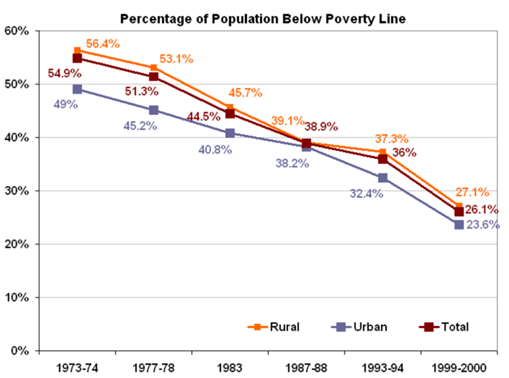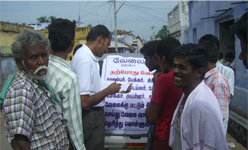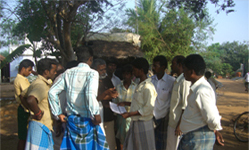According to a 2005 World Bank estimate, 42% of India's population falls below the International poverty line of $1.25 a day (Purchasing Power Parity (PPP), in nominal terms Rs. 21.6 a day in urban areas and Rs 14.3 in rural/urban areas).
Statistics:
Below poverty line (BPL) in India:

Source: Ministry of Statistics and Program Implementation, Government of India.
According to the criterion used by the Planning Commission of India, 27.5% of the population was living below the poverty line in 2004-2005, down from 51.3% in 1977-1978, and 36% in 1993-1994. About 27.1% of Rural/Urban Indian population lives 'Below the poverty' (BPL) line in 1999-2000.
Challenges of BPL population:
In 1999-2000, the Planning Commission of India had fixed the poverty line in Rural/Urban India at Rs.328 per capita per month. The social factors like illiteracy, unemployment, large family size, and caste system are responsible for poverty. As per respective ministries of Government of India, the summation of minimum costs for nutrition (Rs. 573), health (Rs. 30), clothing (Rs. 17), energy consumption (Rs. 55) and miscellaneous expenditure (Rs. 164); the total sum of expenditure for the rural/urban poor would be around Rs. 840 per capita per month. There is already a shortage of Rs. 512 (Rs. 840 - Rs. 328) per capita per month.
The BPL population does not have access to unquantifiable variables like drinking water, proper shelter, sanitation, quality secondary education, or an all-weather road with public transport and the four quantified variables namely - nutrition, healthcare, clothing and energy consumption is at stake. The BPL population does not have access to information related to skills/jobs for enhancing their livelihood.


Our Impact:
1. NaukriSMS empowers BPL population by providing skill/job information all throughout the year through simple, vernacular and technology delivery.
2. Skill/Job alerts are sent to the employed/unemployed, skilled/semi-skilled /unskilled workers enabling them to get trained and be employable.
3. By facilitating skill training information with the incentive of job information on acquiring the skills motivates people to get trained.
4. The daily job information platform reduces poverty, creates a sustainable livelihood by way of employment as many of the skills falls under daily demand.
5. All the allied benefits of poverty reduction like nutrition, healthcare, education are also met.










